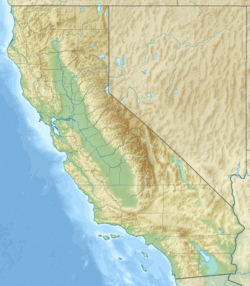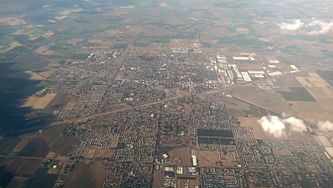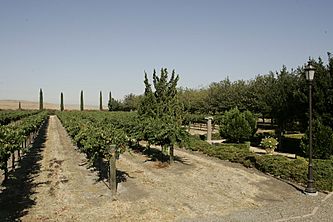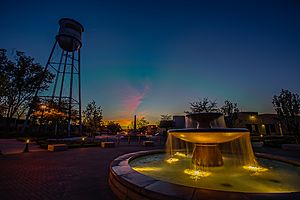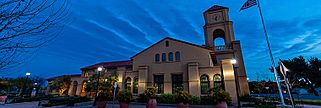Tracy, California facts for kids
Quick facts for kids
Tracy, California
|
||
|---|---|---|
|
||
| Motto(s):
Think Inside the Triangle
|
||
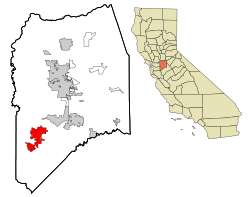
Location in San Joaquin County and the state of California
|
||
| Country | United States | |
| State | California | |
| County | San Joaquin | |
| Incorporated | July 22, 1910 | |
| Government | ||
| • Type | City Manager | |
| Area | ||
| • Total | 26.03 sq mi (67.42 km2) | |
| • Land | 25.90 sq mi (67.07 km2) | |
| • Water | 0.14 sq mi (0.35 km2) 0.61% | |
| Elevation | 52 ft (16 m) | |
| Population
(2020)
|
||
| • Total | 93,000 | |
| • Rank | 78th in California | |
| • Density | 3,573/sq mi (1,379/km2) | |
| Time zone | UTC−8 (Pacific) | |
| • Summer (DST) | UTC−7 (PDT) | |
| ZIP codes |
95304, 95376–95378, 95385, 95391
|
|
| Area code | 209 | |
| FIPS code | 06-80238 | |
| GNIS feature IDs | 277621, 2412090 | |
Tracy is the second most populated city in San Joaquin County, California, United States. The population was 93,000 at the 2020 census. Tracy is located inside a geographic triangle formed by Interstate 205 on the north side of the city, Interstate 5 to the east, and Interstate 580 to the southwest.
Contents
History
The origins of Tracy are related to the mid-19th century construction of Central Pacific Railroad lines running from Sacramento through Stockton and to the San Francisco Bay Area. Tracy is part of the San Jose-San Francisco-Oakland, CA Combined Statistical Area, an extension of the Bay Area. A number of small communities sprang up along these lines, including the one named for railroad director Lathrop J. Tracy. Incorporated in 1910, Tracy grew rapidly and prospered as an agricultural area even when railroad operations began to decline in the 1950s. Beginning in the 1980s, Tracy experienced a growth spurt as people migrated to the city looking for affordable alternatives to Bay Area home prices, in addition to a more tranquil lifestyle. A steady period of growth ensued, as many companies found Tracy an ideal location for their distribution facilities.
Geography
Located in the Central Valley, Tracy is near both fertile and (due to a region of hills west of Tracy) infertile agricultural lands. Tracy has a Mediterranean climate.
Some of this land (in the east and mostly north of Tracy because of the moist Delta river system) has come under increasing development pressure. The San Francisco Bay Area's vigorous population growth has spilled over into the Tracy area as well as other locations, such as the new town of Mountain House. Tracy passed Measure A in 1990 in an attempt to contain and limit development.
In an effort to reduce environmental impacts of the city, it launched the Emerald Tracy Project in September 2009. City spokesman Matt Robinson said that if it succeeds, Tracy will be the second city after Riverside, California to satisfy the state's goal for sustainable communities.
Climate
Tracy is marked by a semi-arid climate (Köppen BSh), with cool, moist winters and very hot and dry summers, displaying Mediterranean characteristics. December and January are the coolest months, and average around 47.1 °F (8.4 °C), and there are 19 nights with lows at or below freezing annually, with the coldest night of the year typically bottoming out below 30 °F (−1 °C). July is the warmest month, averaging 76.4 °F (24.7 °C); normally, there are 18 days of 100 °F (38 °C)+ highs and 82 days of 90 °F (32 °C)+ highs. Average annual precipitation is around 12.5 inches (320 mm), which, by definition, results in the area being classified as a semi-desert.
| Climate data for Tracy Pumping Plant (1991–2020 normals, extremes 1955–present) | |||||||||||||
|---|---|---|---|---|---|---|---|---|---|---|---|---|---|
| Month | Jan | Feb | Mar | Apr | May | Jun | Jul | Aug | Sep | Oct | Nov | Dec | Year |
| Record high °F (°C) | 74 (23) |
77 (25) |
88 (31) |
97 (36) |
107 (42) |
112 (44) |
112 (44) |
111 (44) |
112 (44) |
102 (39) |
85 (29) |
74 (23) |
112 (44) |
| Mean daily maximum °F (°C) | 56.3 (13.5) |
61.9 (16.6) |
67.4 (19.7) |
73.2 (22.9) |
80.2 (26.8) |
88.1 (31.2) |
93.3 (34.1) |
92.5 (33.6) |
88.8 (31.6) |
79.1 (26.2) |
65.6 (18.7) |
56.6 (13.7) |
75.2 (24.0) |
| Daily mean °F (°C) | 48.4 (9.1) |
52.8 (11.6) |
57.2 (14.0) |
61.7 (16.5) |
67.7 (19.8) |
73.7 (23.2) |
77.6 (25.3) |
77.2 (25.1) |
74.5 (23.6) |
66.8 (19.3) |
55.9 (13.3) |
48.5 (9.2) |
63.5 (17.5) |
| Mean daily minimum °F (°C) | 40.5 (4.7) |
43.7 (6.5) |
47.0 (8.3) |
50.2 (10.1) |
55.2 (12.9) |
59.4 (15.2) |
61.9 (16.6) |
61.9 (16.6) |
60.2 (15.7) |
54.5 (12.5) |
46.1 (7.8) |
40.3 (4.6) |
51.7 (10.9) |
| Record low °F (°C) | 18 (−8) |
23 (−5) |
25 (−4) |
29 (−2) |
34 (1) |
37 (3) |
44 (7) |
42 (6) |
40 (4) |
30 (−1) |
24 (−4) |
17 (−8) |
17 (−8) |
| Average precipitation inches (mm) | 2.51 (64) |
2.32 (59) |
1.60 (41) |
0.84 (21) |
0.52 (13) |
0.13 (3.3) |
0.00 (0.00) |
0.01 (0.25) |
0.08 (2.0) |
0.67 (17) |
1.32 (34) |
2.37 (60) |
12.37 (314) |
| Average snowfall inches (cm) | 0.0 (0.0) |
0.0 (0.0) |
0.0 (0.0) |
0.0 (0.0) |
0.0 (0.0) |
0.0 (0.0) |
0.0 (0.0) |
0.0 (0.0) |
0.0 (0.0) |
0.0 (0.0) |
0.0 (0.0) |
0.0 (0.0) |
0.0 (0.0) |
| Average precipitation days (≥ 0.01 in) | 12.9 | 9.6 | 8.4 | 4.8 | 2.7 | 0.9 | 0.0 | 0.3 | 0.5 | 2.5 | 6.7 | 11.8 | 61.1 |
| Average snowy days (≥ 0.1 in) | 0.0 | 0.0 | 0.0 | 0.0 | 0.0 | 0.0 | 0.0 | 0.0 | 0.0 | 0.0 | 0.0 | 0.0 | 0.0 |
| Source: NOAA | |||||||||||||
Demographics
| Historical population | |||
|---|---|---|---|
| Census | Pop. | %± | |
| 1910 | 596 | — | |
| 1920 | 1,238 | 107.7% | |
| 1930 | 3,829 | 209.3% | |
| 1940 | 4,056 | 5.9% | |
| 1950 | 8,410 | 107.3% | |
| 1960 | 11,289 | 34.2% | |
| 1970 | 14,724 | 30.4% | |
| 1980 | 18,428 | 25.2% | |
| 1990 | 33,558 | 82.1% | |
| 2000 | 56,929 | 69.6% | |
| 2010 | 82,922 | 45.7% | |
| 2020 | 93,000 | 12.2% | |
| 2023 (est.) | 98,010 | 18.2% | |
| U.S. Decennial Census | |||
2020 census
| Race / Ethnicity (NH = Non-Hispanic) | Pop 2000 | Pop 2010 | Pop 2020 | % 2000 | % 2010 | % 2020 |
|---|---|---|---|---|---|---|
| White alone (NH) | 30,723 | 30,005 | 25,117 | 53.97% | 36.18% | 27.01% |
| Black or African American alone (NH) | 2,976 | 5,636 | 5,737 | 5.23% | 6.80% | 6.17% |
| Native American or Alaska Native alone (NH) | 297 | 297 | 310 | 0.52% | 0.36% | 0.33% |
| Asian alone (NH) | 4,481 | 11,803 | 19,339 | 7.87% | 14.23% | 20.79% |
| Pacific Islander alone (NH) | 275 | 641 | 897 | 0.48% | 0.77% | 0.96% |
| Other race alone (NH) | 182 | 223 | 634 | 0.32% | 0.27% | 0.68% |
| Mixed race or Multiracial (NH) | 2,230 | 3,760 | 4,969 | 3.92% | 4.53% | 5.34% |
| Hispanic or Latino (any race) | 15,765 | 30,557 | 35,997 | 27.69% | 36.85% | 38.71% |
| Total | 56,929 | 82,922 | 93,000 | 100.00% | 100.00% | 100.00% |
2010 census
The 2010 United States Census reported that Tracy had a population of 82,922. The population density was 3,745.5 inhabitants per square mile (1,446.1/km2). The racial makeup of Tracy was 43,724 (52.7%) White, 5,953 (7.2%) African American, 715 (0.9%) Native American, 12,229 (14.7%) Asian, 747 (0.9%) Pacific Islander, 13,173 (15.9%) from other races, and 6,381 (7.7%) from two or more races. Hispanic or Latino of any race were 30,557 persons (36.9%).
The Census reported that 82,606 people (99.6% of the population) lived in households, 69 (0.1%) lived in non-institutionalized group quarters, and 247 (0.3%) were institutionalized.
There were 24,331 households, out of which 13,143 (54.0%) had children under the age of 18 living in them, 15,122 (62.2%) were opposite-sex married couples living together, 3,196 (13.1%) had a female householder with no husband present, and 1,627 (6.7%) had a male householder with no wife present. There were 1,501 (6.2%) unmarried opposite-sex partnerships, and 184 (0.8%) same-sex married couples or partnerships. 3,326 households (13.7%) were made up of individuals, and 1,026 (4.2%) had someone living alone who was 65 years of age or older. The average household size was 3.40. There were 19,945 families (82.0% of all households); the average family size was 3.72.
The population was spread out, with 26,668 people (32.2%) under the age of 18, 7,476 people (9.0%) aged 18 to 24, 23,826 people (28.7%) aged 25 to 44, 19,202 people (23.2%) aged 45 to 64, and 5,750 people (6.9%) who were 65 years of age or older. The median age was 32.3 years. For every 100 females, there were 98.3 males. For every 100 females age 18 and over, there were 94.9 males.
There were 25,963 housing units at an average density of 1,172.7 units per square mile (452.8 units/km2), of which 16,163 (66.4%) were owner-occupied, and 8,168 (33.6%) were occupied by renters. The homeowner vacancy rate was 2.5%; the rental vacancy rate was 5.9%. 54,275 people (65.5% of the population) lived in owner-occupied housing units and 28,331 people (34.2%) lived in rental housing units.
Arts and culture
Historical monuments
Tracy City Hall and Jail was first commissioned by the city in November–December 1899 and completed in March 1900 after the original Jail and city hall was burnt down. This historical site served as the local governments place of operation during Tracy's formative years, which makes this building an integral part of Tracy's foundation. The structure is made of a simple brick building that is 24 by 43 feet in dimension located on 25 West Seventh Street, and was built by J.F. Hoerl. In the historical resources inventory, the Tracy City Hall and Jail was one of only fourteen buildings to receive and "exceptional" rating.
The Tracy Inn was originally opened in 1927 with a total of 60 rooms on the second floor and is still located on 24 West Eleventh Street. The building has a very transitional architectural style befitting the 1920s with a classic Spanish Colonial revival and modern styles mixed together. The building was designed by the Oakland firm of Slocomhe and Tuttle. In 1949, after the ownership changed, the Tracy Inn suffered with a fire that burned the only original blue prints of the building. Even with this loss the owner was still able to recreate the original look of the Tracy Inn. The iconic sign of the Tracy Inn has also been replaced in 1945.
Education
Three public school districts serve the city of Tracy. The largest and most recognized is the Tracy Unified School District. This school system incorporates many elementary and middle schools as well as five Tracy high schools: Tracy High School, Merrill F. West High School, Delta Charter High School, Millennium Charter High School,Tracy Independent Study Charter School and John C. Kimball High School.
Tracy's students with behavioral issues attend the Willow Community Day School, and the Tracy One Program, or Community One. The other two school districts are: Lammersville Joint Unified School District, which includes six K-8 schools (Peter Hansen Elementary, Julius Cordes Elementary, Wicklund Elementary, Bethany Elementary, Questa Elementary, and Altamont Elementary) along with Mountain House High School, which was opened in 2014. and Jefferson School District. The latter covers the south side of Tracy and includes four schools: Jefferson Middle School, Tom Hawkins Elementary School, Monticello Elementary School and Anthony C. Traina School.
Media
Tracy's daily newspaper is the Tracy Press, a once-weekly newspaper. Bilingual Weekly News covers Tracy in English and Spanish.
Infrastructure
Transportation
Public transportation
Tracy is served by several bus services: locally, Tracer runs seven lines that serve as circulators between major transit hubs, shopping, school, residential, and downtown areas. San Joaquin Regional Transit District (SJRTD) runs two county hopper routes that connect the city with other San Joaquin County communities and one commuter route that runs to Dublin/Pleasanton BART station.
Greyhound, Tracer, and SJRTD all connect with taxis, bike stations, and parking at the Tracy Transit Center, a transit station built in 2010. Amtrak Thruway buses serve the city's bus station to connect the area with six daily trips to the South Bay and two to San Francisco, all of which stop at BART and job centers in Livermore.
South Tracy offers the Altamont Corridor Express (ACE) service at Tracy (ACE station), which provides commuter rail transportation to the Bay Area and connects with VTA in San Jose, BART via shuttle in Pleasanton and Fremont, in addition to Amtrak train in Santa Clara and San Jose. Valley Link is planned to pass through Tracy and provide a passenger rail service connecting directly to BART. Intercity passenger rail service to Tracy ended in 1971 with the formation of Amtrak.
Major highways
Interstate 205 passes along the north side of the city and connects the nearby Interstates 580 to the west and 5 on the east, with the three Interstates forming a triangle around much of the city. Business Loop 205 runs through the center of Tracy along 11th Street, formerly a portion of U.S. Highway 50. In addition, the northern terminus of State Highway 33 is located at South Bird Road and Interstate 5 southeast of Tracy.
Aviation
Tracy is served by Tracy Municipal Airport, located south of the city. It serves general aviation; there is no scheduled airline service from the airport.
Notable people
- Cody Bolton – MLB pitcher (Pittsburgh Pirates)
- Sandra Cantu – homicide victim in 2009
- Keyshia Cole – American singer, songwriter, actress, and television producer
- Troy Dayak – soccer player/coach
- Nick Eddy – former NFL player
- Gilbert Fuentes – (born February 21, 2002) American professional soccer player for Austin Bold on loan from Major League Soccer San Jose Earthquakes.
- MC Hammer – American rapper, dancer, entertainer, actor, business entrepreneur
- Rod Lauren – singer/actor
- Thia Megia – singer, finalist on American Idol season ten.
- John Moore – racing driver
- Matt Overton – active NFL player- Jacksonville Jaguars
- Bubba Paris – former NFL football star
- Steve Perry – Singer from Journey (Banta)
- Ryan Philpott – racing driver
- Richard Pombo – former United States Representative
- Saweetie - American rapper/songwriter
- Keena Turner – football star
Sister cities
Tracy has been a sister city of Memuro, Hokkaido since 1989. The city is also a sister city of Velas in the Azores.
See also
 In Spanish: Tracy (California) para niños
In Spanish: Tracy (California) para niños







